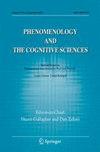做科学的意义:关于指导积极科学方法的一些实用主题
IF 1.9
1区 哲学
0 PHILOSOPHY
引用次数: 0
摘要
Abstract In this article, I will explore the enactive approach to science and the pragmatic motifs that guide it.特别是,在文章的前半部分,我将讨论在多大程度上颁布主义可被视为一种自然哲学,并通过与塞拉斯对人类在世界中的显现形象与科学形象之间冲突的解释进行比较,重点探讨颁布主义所捍卫的自然观。在第二部分中,我将比较积极方法与杜威的有机体-环境互动概念,重点关注他们的进化观之间的潜在相似之处,以及他们将科学视为有机体感性认识的最复杂表达方式的方式。本文章由计算机程序翻译,如有差异,请以英文原文为准。
Making sense of doing science: on some pragmatic motifs guiding the enactive approach to science
Abstract
In this article, I will explore the enactive approach to science and the pragmatic motifs that guide it. In particular, in the first half of the article, I will discuss to what extent enactivism can be seen as a philosophy of nature, and by comparing it with Sellars’s interpretation of the conflict between the manifest and the scientific image of humans in the world, I will focus on the view of nature that enactivism defends. In the second part, I will compare the enactive approach with Dewey’s conception of the organism-environment interaction by focusing on the underlying similarities between their views of evolution and their way of seeing science as the most sophisticated expression of an organism’s sense-making.
求助全文
通过发布文献求助,成功后即可免费获取论文全文。
去求助
来源期刊

Phenomenology and the Cognitive Sciences
PHILOSOPHY-
CiteScore
5.00
自引率
8.70%
发文量
72
期刊介绍:
Phenomenology and the Cognitive Sciences is an interdisciplinary, international journal that serves as a forum to explore the intersections between phenomenology, empirical science, and analytic philosophy of mind. The journal represents an attempt to build bridges between continental phenomenological approaches (in the tradition following Husserl) and disciplines that have not always been open to or aware of phenomenological contributions to understanding cognition and related topics. The journal welcomes contributions by phenomenologists, scientists, and philosophers who study cognition, broadly defined to include issues that are open to both phenomenological and empirical investigation, including perception, emotion, language, and so forth. In addition the journal welcomes discussions of methodological issues that involve the variety of approaches appropriate for addressing these problems. Phenomenology and the Cognitive Sciences also publishes critical review articles that address recent work in areas relevant to the connection between empirical results in experimental science and first-person perspective.Double-blind review procedure The journal follows a double-blind reviewing procedure. Authors are therefore requested to place their name and affiliation on a separate page. Self-identifying citations and references in the article text should either be avoided or left blank when manuscripts are first submitted. Authors are responsible for reinserting self-identifying citations and references when manuscripts are prepared for final submission.
 求助内容:
求助内容: 应助结果提醒方式:
应助结果提醒方式:


